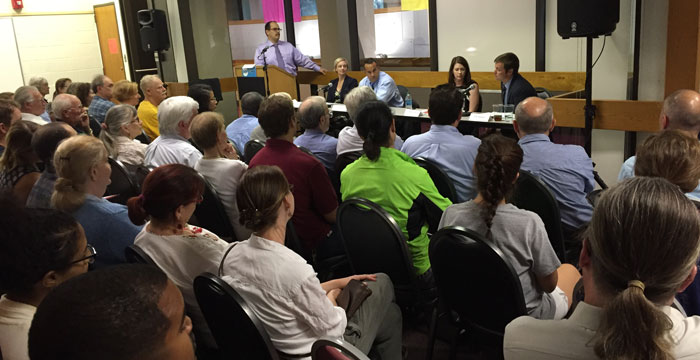
How Transportation Pollution Affects Low Income Philadelphians: Rountable RECAP
Guest post by Russell Zerbo on behalf of the Clean Air Council addresses transportation pollution locally and recaps a recent roundtable on August 23rd.
Transportation is now the largest source of carbon dioxide pollution in the United States, although in Pennsylvania power plants still emit the most CO2 by far. With this dichotomy in mind, I helped PennFuture’s Outreach Coordinator Zakia Elliot organize a panel of city officials to discuss what Philadelphia is doing to reduce pollution and improve public health. Although Philadelphia Energy Solutions remains the largest oil refinery on the East Coast, the largest single source of pollution in our city and a thorn in the side of clean air advocates; we decided to focus on that most evasive and personal pollution source, transportation.
In her opening remarks last Tuesday, State Representative Donna Bullock (D-195) mentioned that transportation is the third largest expense for low-income residents, behind food and shelter. Bullock confronted the thorny issue of Philly’s renewed real estate market driving up pollution levels. “While the middle class is driving this growth it is the lower class who suffers,” Bullock said. In 2015, Philadelphia experienced four red ozone days for the first time in three years. This year, Philadelphia has already witnessed three red ozone days, in addition to breaking an 114-year-old precipitation record as well as a 1999 heat record. It’s hard to rationalize the pollution reductions that often come with poverty, but it’s indisputable that our most extreme recession came with the largest cut in CO2 seen since records began in 1990.
“Electricity charging stations come with free parking, but that is not an equitable solution,” said Christine Knapp, Director of the Mayor’s Office of Sustainability. I appreciated this acknowledgment in the context of a recent report that found U.S. cities are becoming both richer and poorer with New York, Dallas and Philadelphia leading the way. Discussing individual driving habits, Knapp affirmed that, “A lot of lower-income people work outside the city, there is an equity issue that needs to be addressed.”
Jessica Caum, MA MPH CPH, within the Bioterrorism and Public Health Preparedness Division of the Health Department, emphasized “educating the public on the immediate consequences of their actions” and “making connections between climate change and health.” Personally, as someone who encourages public officials to adopt concrete pollution-reduction measures, Caum’s more balanced perspective can be difficult to accept. However, as a frequent exhibitor at community events and fairs, education is as necessary as any bill or budget. This component of the broader campaign to reduce the use of fossil fuels cannot be overlooked, particularly when a substantial obstacle to sustainability is Philly’s nation-leading poverty. The Netherlands is currently making progress to ban all fossil fuel vehicles by 2025, but is this ethical in a city already struggling to make ends meet? I heard Caum’s message to mean that only when Philadelphians consider driving on par with other risky and dangerous behavior will we be in the position to seriously reduce automobile pollution. The panel reiterated that although increased tolls and fuel taxes are great sources of revenue for public transportation projects, they do not affect behavior significantly.
“Philadelphia has one of the lowest vehicle-miles traveled (VMT) rates in the country, a lot of which has to do with poverty,” said Erik Johanson, director of innovation at SEPTA. Philly’s low VMT rate is also driven by its expansive public transit system. SEPTA’s ridership is more than Los Angeles and Houston’s public transit networks combined, even though both cities have significantly larger populations. This disparity is easily seen in pollution levels. Last year, Philadelphia had 33 days when it was dangerous for vulnerable populations to be outside, compared to LA’s 198 and Houston’s 49. Sadly, this is not the sole indicator of air pollution. Philadelphia’s 22% childhood asthma rate is higher than LA or Houston, possibly due to increased indoor air pollution sources like mold and pests in our significantly older city.
Last week’s Roundtable on Transportation Pollution, hosted by PennFuture and Clean Air Council, provided a tremendous outlet for the conflicts that confront Philadelphians. Attendees connected widespread fracking across Pennsylvania to Philadelphia’s nation-leading natural gas utility in addition to the economic contexts of sustainability.
Activists in the audience reminded speakers of Philadelphia’s commitment to reduce carbon dioxide pollution 80% by 2050 and asked how it would be realized. While the roundtable was targeted at transportation pollution, Knapp reiterated that “60% of the city’s greenhouse gasses are from electricity used in buildings, and stationary sources are easier to target.”
Benchmarking and reducing the energy consumption of the city’s largest buildings are the centerpieces of the city’s Greenworks program, a new version of which will be debuted in the fall.








